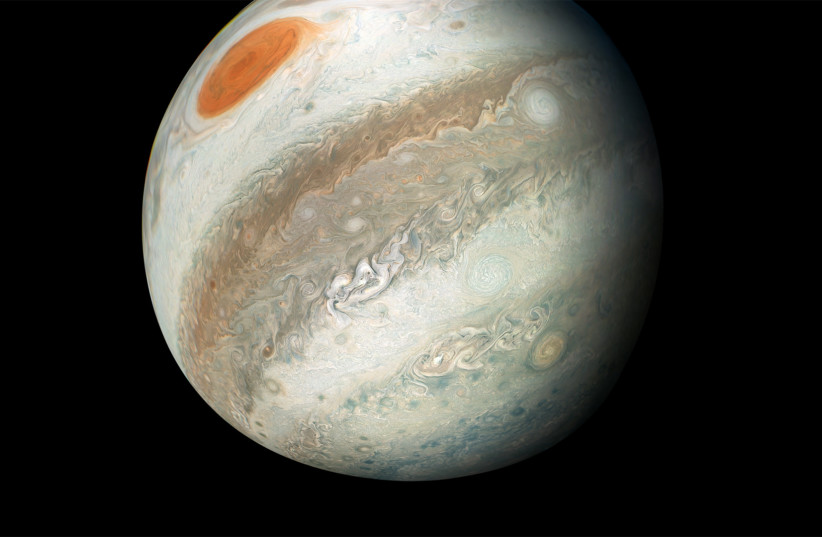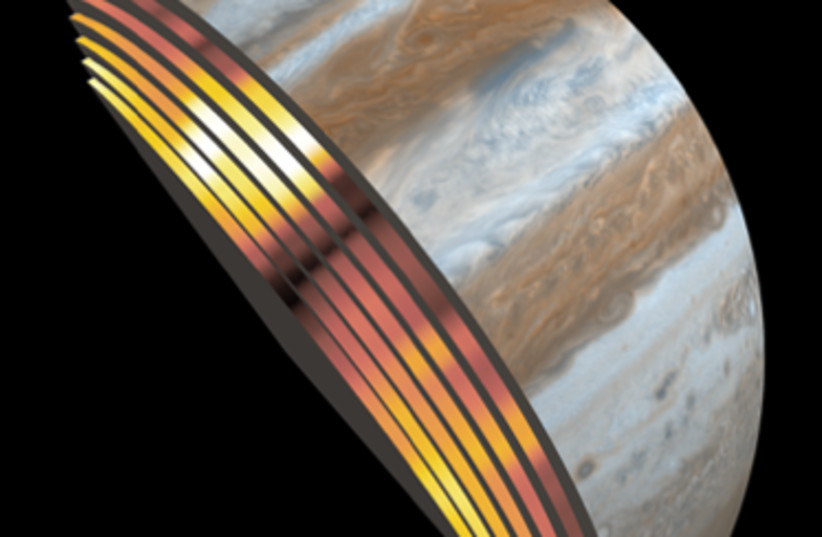Spot on: NASA, Israelis reveal in-depth measurement of Jupiter’s red spot
The mysterious Great Red Spot has been the fifth planet from the Sun’s most famous characteristic for centuries. Why does it exist? What has kept this storm brewing for so long?
By AARON REICH
Jerusalem Post, OCTOBER 28, 2021

Jupiter’s Great Red Spot as captured by the JunoCam. (photo credit: NASA)
Scientists from NASA and Israel’s Weizmann Institute of Science have completed the first-ever, in-depth measurement of Jupiter’s red spot and revealed new information about the formation of storms on the solar system’s largest planet.
The
mysterious Great Red Spot has been the fifth planet from the Sun’s most
famous characteristic for centuries. Its existence was first verified
in the 1800s, though earlier accounts suggest it may have existed for
well over 360 years.
It
is the largest known storm in the solar system, and its bright-red
color and distinctive shape and appearance have made it one of the most
recognizable features on nearby planets, alongside the great rings of
Saturn.
But its existence has often been puzzling. Why does it exist? What has kept this storm brewing for so long?
Not
all of these questions have been answered, but the findings of this new
study, published in the academic journals Science and Geophysical
Research Letters, have revealed more information about this strange
phenomenon.
Animation of Jupiter's jet streams. (Credit: YOHAI KASPI (WEIZMANN INSTITUTE))
The
research was built on methodology created by Weizmann Institute
scientists Prof. Yohai Kaspi and Dr. Eli Galanti. It was planned by
them, together with Dr. Marzia Parisi, formerly of the Weizmann
Institute and now a researcher at NASA’s Jet Propulsion Laboratory.
This
experiment was centered around the Juno mission, a space probe that was
launched a decade ago and reached Jupiter’s orbit in 2016. Studying the
Great Red Spot in this manner was not something the mission was
originally planned for, but Kaspi and his team had proposed an
experiment: a flyby of the planet dedicated to gravity measurements.
“When
the spacecraft flies around Jupiter, we feel the gravity’s pull,” Kaspi
said in an interview. “When you have some kind of a flow, you have
small variations in density, and those affect the gravity.”
Jupiter Jet Stream's 'Shift Into Reverse' Explained by NASA
“If
you have a storm on Earth, it connects it to a small change in pressure
and density,” he said. “The gravity one feels flying above the storm is
the sum of all that gravity underneath you. So if there’s a variation,
that’s something you feel in a spacecraft or aircraft.
“On Earth, the atmosphere is so small, you don’t really feel it. But on Jupiter, because the atmosphere is so massive and the planet has no surface, it really makes a difference.”
The difference itself is still very small though, Kaspi said.
“If
you weighed 70 kg. before, then you’d weigh 70.00001 kg.,” he said.
“That’s the kind of difference we’re talking about. But our instruments
are sensitive enough to sense that. On Earth, which is a solid planet
with a thinner atmosphere, the situation is completely different.”
Unlike
Earth, Jupiter is a gas giant, meaning it isn’t solid rock. While gas
giants do have a solid core, this is not the same kind of core as on
Earth, where it is solid like a rock. Rather, it’s that the temperature
and pressure is so high that it’s like a liquid mixing into the gas.
Furthermore,
even if there was a solid core, it would be so far away from where the
probe was flying that it wouldn’t make a difference.
The
findings revealed the sheer depth of the storm – 500 km. For
comparison, if a storm of this size had manifested on Earth, it would
reach the International Space Station, Galanti said the study appearing
in Science.
The
Great Red Spot is far from the only storm on Jupiter. In fact, the
experiment detected the presence of many others that, while smaller than
the Great Red Spot, were still far larger than anything appearing on
Earth.
But why are Jupiter’s storms so different?
Part of this was explained by another discovery in the experiment: Jupiter’s jet streams and Ferrel cells.
Jet
streams are narrow bands of wind in the upper atmosphere. A Ferrel cell
is part of the planetary air circulation. Both are balanced with each
other and are integral for the maintenance and functionality of a
planet’s environment and climate.
On
Earth, there is a single jet stream, flowing from east to west, and two
Ferrel cells, one in the north and one in the south, with the equator
being in the middle.
The
uniqueness of Earth’s Ferrel cells and jet stream is in part due its
rotational speed (completing a rotation every 24 hours).
By
contrast, Jupiter, which completes a rotation every 10 hours, is
different. It has multiple jet streams, going in opposite directions,
and rather than two Ferrel cells, it has 16.

Jet streams and Ferrel cells have divided Jupiter's air circulation
into belts and zones. (credit: YOHAI KASPI (WEIZMANN INSTITUTE))
In
a way, though, this makes Jupiter similar to Earth, as the experiment
found evidence that the jet streams and Ferrel cells affect Jupiter’s
circulation system in a similar way as Earth’s.
It is also the first definitive proof of such a phenomenon occurring on a gas giant.
Could such a phenomenon occur on other worlds?
According to Kaspi, it’s very possible, especially on Saturn.
“We
do know Saturn has jet streams, and we know there are storms there,” he
explained. “However, there are no missions planned for Saturn, and it
is unlikely we will have evidence any time soon.”
The
situation is not as clear with Uranus and Neptune, which seem to lack
jet streams. Uranus has an irregular rotation, rotating on its side
rather than the same way other planets do. But Neptune does not, so it
is unclear if that plays a role. Kaspi said it is possible their
distance from the Sun is a factor, meaning their temperatures are
different, but this is unclear.
Venus,
too, is another story. The second planet from the Sun has an atmosphere
over 90 times denser than that of Earth, and jet streams do exist in
the upper atmosphere, though they go west to east. However, its rotation
is much slower.
So what do jet streams have to do with the Great Red Spot?
This, at the very least, is one thing we do know.
“The
Great Red Spot sits in between two jet streams,” Kaspi said. “One
reason it doesn’t disappear is that the two jet streams fuel it. Storms
on Earth last maybe one or two weeks. But there’s just one jet stream
here. On Jupiter, because there are multiple jet streams, storms always
sit between the jets.”
But if there are so many jet streams on Jupiter, why is there only one Great Red Spot?
“We
don’t know,” Kaspi admitted. “There are storms on Jupiter that last
years and even decades, but nothing like the Great Red Spot, which has
lasted for centuries. We don’t know why it’s so special.
“The
configuration of jet streams in that spot is maintaining it, but we
don’t know exactly why it’s doing it for this storm alone. We do know
that it goes deep – 500 km. – and the pressure there is like the bottom
of the ocean on Earth, so it contains enough mass that it won’t
dissolve. But why is this storm so deep?”
That isn’t the only remaining mystery about the Great Red Spot.
“We
also don’t know why the Great Red Spot is red,” Kaspi said. “We know
it’s a photochemical effect. But we don’t know why it happens and why
it’s so distinctively different compared to the rest of the atmosphere.”
It
is possible, though, that another storm like the Great Red Spot could
appear, either on Jupiter or, though more unlikely, on Saturn. But we
don’t know how.
In
addition, it is possible, in theory, that other factors could impact
the jet streams and Ferrel cells, as climate change is doing on Earth.
But it is highly unlikely that could happen on Jupiter, where humanity
has not tampered with the climate.
Until
more information is gathered, the Great Red Spot will remain as it is:
an iconic phenomenon in the solar system teeming with mysteries.
Please recommend this page & follow the Sputniks Orbit


No comments:
Post a Comment